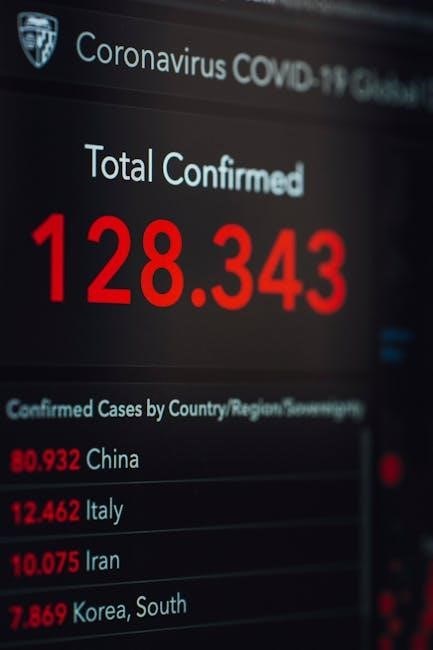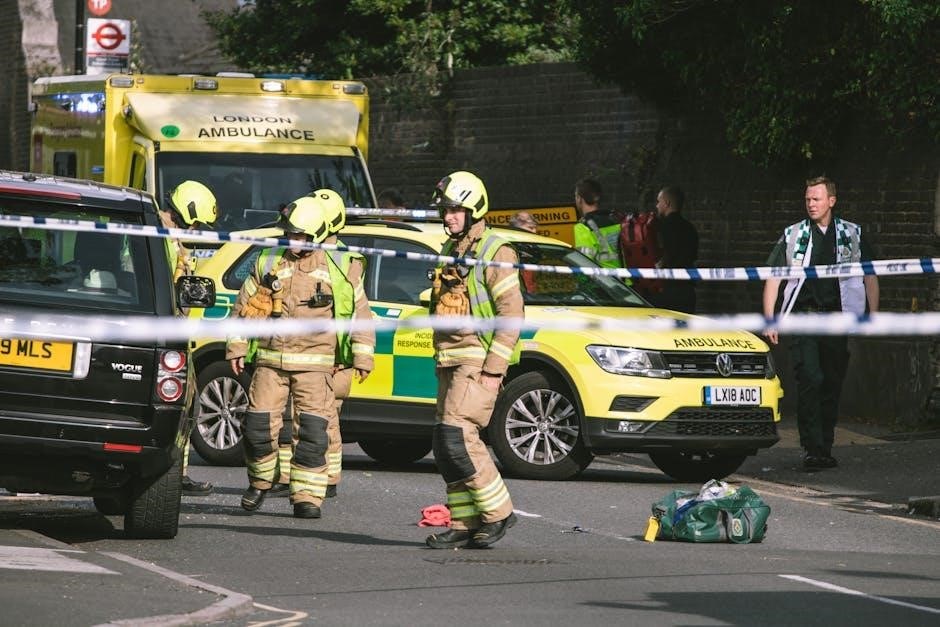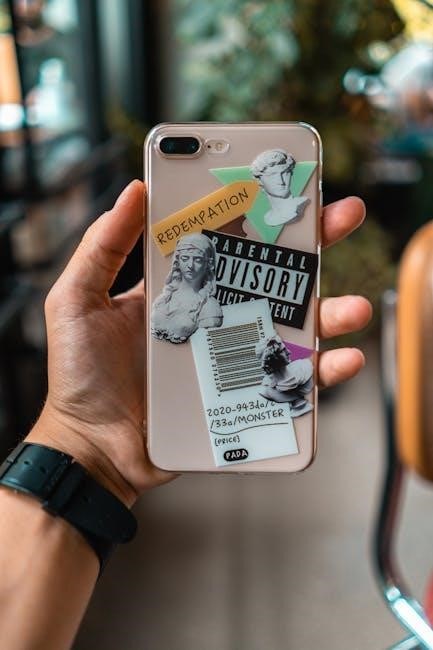Printable Emergency Stickers PDF: An Overview
Emergency stickers offer a swift way to communicate crucial information during crises. A printable PDF allows for quick access to templates, enabling users to create customized stickers. These can include medical details, contact information, or emergency exits.
Understanding the Need for Emergency Stickers
Emergency stickers bridge communication gaps when time is critical. They provide essential details to first responders or bystanders. Having printable versions ensures immediate availability and customization to suit individual needs and specific situations.
Why Emergency Stickers are Important
Emergency stickers are vital because they offer immediate access to critical information during urgent situations. In moments where communication is difficult or impossible, these stickers speak for you. They can quickly convey medical conditions, allergies, emergency contacts, or evacuation routes. This rapid information transfer can significantly improve response times and ensure appropriate assistance is provided, potentially saving lives. Printable emergency stickers allow for customized, readily available safety measures.
Common Uses of Emergency Stickers
Emergency stickers find application in diverse scenarios, enhancing safety and preparedness. They are commonly used on vehicles to alert first responders to medical conditions of occupants, especially children. Within homes, they mark emergency exits, first aid kit locations, or fire extinguisher placement. Schools and workplaces utilize them to indicate evacuation routes and emergency contact details. Medical stickers on personal belongings can inform healthcare providers of allergies or chronic illnesses. These stickers are essential for quick, clear communication during crises.

Types of Printable Emergency Stickers
Printable emergency stickers are diverse. They include emergency contact stickers with phone numbers, medical information stickers for allergies, emergency exit signs for safety, and first aid stickers indicating supply locations. Each type serves a unique informational purpose.
Emergency Contact Stickers
Emergency contact stickers are crucial for quickly providing vital contact details during emergencies. These stickers typically include names and phone numbers of individuals to notify in case of an accident or sudden health issue. They can be placed on phones, in wallets, or on belongings to ensure first responders can easily find and reach designated contacts. Having easily accessible emergency contact information streamlines communication and enables faster assistance when it matters most. Printable templates make creating these stickers simple.
Medical Information Stickers
Medical information stickers are designed to provide essential health details to first responders in emergency situations. These stickers typically include information like allergies, medications, blood type, and pre-existing conditions. Affixing these stickers to personal items such as wallets, phones, or medical devices ensures that vital medical data is readily available to paramedics or healthcare professionals. This information helps them make informed decisions and provide appropriate care quickly. Printable templates allow for easy customization, ensuring all critical health details are accurately and legibly displayed.
Emergency Exit Stickers
Emergency exit stickers are vital safety tools used to clearly mark escape routes during fires or other urgent situations. These stickers often feature universally recognized symbols and bright colors to enhance visibility, even in low-light conditions. Strategically placed near doorways, hallways, and stairwells, they guide individuals to the nearest safe exit. Printable templates offer customizable sizes and designs to suit various environments, such as homes, offices, and public buildings. Ensuring these stickers are prominently displayed and regularly inspected can significantly improve evacuation efficiency and safety during emergencies.
First Aid Stickers
First aid stickers are essential for quickly locating first aid kits and related supplies in homes, workplaces, and public areas. These stickers typically feature the internationally recognized symbol of a white cross on a green background, making them easily identifiable. Printable templates allow for customization, enabling users to add specific instructions or contact information for emergency responders. By clearly marking the location of first aid resources, these stickers help ensure that individuals can promptly access necessary medical assistance during emergencies, potentially minimizing injuries and saving lives. Regular inspection ensures continued visibility and effectiveness.

Creating Your Own Printable Emergency Stickers
Crafting personalized emergency stickers involves selecting templates, designing for clarity, and including vital information. This customization allows for tailoring stickers to specific needs, ensuring they effectively communicate essential details in critical situations.
Choosing the Right Template
Selecting the correct template is crucial for effective emergency stickers. Consider the sticker’s purpose, size, and the amount of information it needs to convey. Templates vary from simple contact cards to detailed medical information sheets. Ensure the layout accommodates text and symbols clearly. A well-chosen template streamlines the design process, saving time and ensuring the final product is easily readable and understandable during emergencies. Prioritize templates that offer customization options to tailor the sticker to your specific requirements, maximizing its utility and impact.
Designing Effective Stickers
Effective emergency sticker design hinges on clarity and conciseness. Use easily recognizable symbols, such as the medical alert symbol or a simple phone icon, to convey immediate meaning. Choose a font that is legible and appropriately sized, even from a distance. High contrast color schemes, like black on yellow or white on red, enhance visibility. Prioritize essential information and avoid cluttering the sticker with unnecessary details. A well-designed sticker ensures vital information is quickly understood, potentially saving valuable time during critical situations. Remember, simplicity and clarity are paramount for effective communication.
Information to Include on Emergency Stickers
When creating emergency stickers, prioritize including essential data. For medical stickers, list allergies, medications, and any pre-existing conditions. Emergency contact stickers should feature the names and phone numbers of individuals to notify in case of an emergency. For children’s stickers, include the child’s name, parent’s contact information, and any relevant medical details. Home safety stickers should clearly indicate emergency exits and locations of first aid kits. Vehicle stickers should list important medical information and contact details. Always ensure the information is accurate, up-to-date, and easily readable. Including too much information can be confusing; focus on the most crucial details.

Where to Find Printable Emergency Sticker Templates
Numerous online resources offer printable emergency sticker templates. Printables Hub is one example, providing free PDF templates. Online design tools also allow for customization. Templates range from free options to paid premium designs.
Printables Hub and Similar Resources
Printables Hub stands out as a valuable platform, offering a variety of free, printable emergency card templates in PDF format. These resources recognize that health emergencies can arise unexpectedly, emphasizing the importance of preparedness. Beyond Printables Hub, similar websites provide downloadable templates suitable for creating emergency stickers. Users can often find templates for medical information, emergency contacts, and other essential details. These resources aim to simplify the process of creating vital safety tools.
Online Design Tools
Online design tools offer a flexible approach to creating customized emergency stickers. Platforms like Canva and Adobe Express provide templates that users can modify to fit their specific needs. These tools often feature drag-and-drop interfaces, making it easy to add text, symbols, and colors. Users can incorporate medical information, emergency contacts, or specific safety instructions. The ability to personalize designs ensures that the stickers are tailored to the intended recipient or situation, enhancing their effectiveness in conveying critical details during emergencies.
Free vs. Paid Templates
When choosing emergency sticker templates, consider the trade-offs between free and paid options. Free templates are readily accessible but may offer limited customization and design choices. Paid templates typically provide a wider range of professional designs, higher resolution graphics, and more extensive customization capabilities. While free templates can be suitable for basic emergency stickers, paid templates are often a better choice when a polished, highly customized, and easily readable design is essential. Evaluating your specific needs and budget will help determine the best option.

Printing Your Emergency Stickers
Printing emergency stickers requires careful consideration of materials and settings. Choosing the right paper, adjusting printer settings, and accurately cutting ensures durable and effective stickers ready for application in crucial locations for quick visibility.
Choosing the Right Paper and Sticker Material
Selecting appropriate paper and sticker material is paramount for longevity and effectiveness. Consider factors like adhesive strength, resistance to weather, and the surface you’ll be applying the sticker. Vinyl offers durability, while paper stickers are suitable for indoor use. Pre-printed sticker sheets simplify the process. Pre-printed hospital stickers can also be purchased from our online shop. Ensure the material is compatible with your printer’s ink for optimal print quality and resistance to smudging or fading when exposed to the elements.
Printer Settings for Optimal Results
Achieving optimal results when printing emergency stickers involves adjusting printer settings. Select the appropriate media type, such as “sticker paper” or “photo paper,” for enhanced ink adhesion. Increase the print quality to “high” or “best” for sharper details. Adjust color settings to ensure accurate color reproduction, especially for important symbols. Perform a test print on plain paper first to verify alignment and color accuracy. Ensure your printer has sufficient ink, and clean the print heads if necessary to prevent streaking or blurring on the final stickers. Proper settings guarantee legibility and durability.
Cutting and Applying the Stickers
Once printed, carefully cut out the emergency stickers using scissors or a craft knife for precision. A paper cutter can be useful for straight edges. Ensure the stickers are cleanly cut to avoid peeling. Before applying, thoroughly clean the surface where the sticker will be placed to remove dirt and grease. Peel the backing off the sticker and carefully align it before pressing it firmly onto the surface. Smooth out any air bubbles to ensure proper adhesion. For added durability, consider applying a clear laminate over the sticker after application.

Customizing Emergency Stickers for Specific Needs
Emergency stickers aren’t one-size-fits-all. Tailor them to specific needs, such as children’s allergies or vehicle information. This customization ensures the stickers provide relevant details for the intended context, enhancing their effectiveness in emergency situations.
Stickers for Children
Stickers designed for children require special attention. Include essential information like allergies, medical conditions, and emergency contact numbers. Keep the design simple and visually appealing to catch attention. Lamination is crucial for durability, especially if attached to backpacks or clothing. Consider using bright colors and recognizable symbols to aid recognition by first responders. Ensure the information is age-appropriate and easy for others to understand quickly in a stressful situation. Prioritize clear, concise details to maximize the sticker’s effectiveness in safeguarding your child.
Stickers for Vehicles
Vehicle emergency stickers provide vital information to first responders after an accident. These stickers should include details about occupants, medical conditions, and emergency contacts. Consider adding information about children or pets traveling in the vehicle. Place stickers in visible locations like the dashboard or on car seats. Use durable, weather-resistant materials to withstand environmental factors. Reflective materials enhance visibility in low-light conditions. Regularly update the information to ensure accuracy. Having readily available information can significantly speed up response times and improve outcomes during emergencies involving vehicles.
Stickers for Home Safety
Home safety stickers are crucial for informing emergency personnel about important details regarding your residence. These stickers can indicate the location of gas shut-off valves, electrical panels, or medical equipment. Include information about residents with special needs, like mobility issues or medical conditions. Place stickers near entrances, exits, and relevant appliances. Consider using glow-in-the-dark or reflective materials for enhanced visibility during power outages. Regularly inspect and update stickers as needed. Clearly marked hazards and critical information aid first responders in efficiently addressing emergencies, minimizing potential damage and ensuring the safety of occupants within the home environment.
Legal Considerations for Emergency Stickers
When creating emergency stickers, be aware of compliance with safety standards and potential liability issues. Ensure symbols and color-coding align with recognized guidelines. Seek legal counsel to understand specific regulations related to emergency signage in your area.
Compliance with Safety Standards
Creating effective emergency stickers involves adhering to established safety standards. These standards dictate the use of specific symbols, colors, and fonts to ensure clarity and universal recognition. For example, the first aid symbol is internationally recognized and should be used consistently. Emergency exit signs must also conform to specific design guidelines to guarantee visibility and understanding during critical situations. Familiarize yourself with relevant ISO standards or local regulations to ensure your printable emergency stickers meet legal and safety requirements, minimizing potential confusion and maximizing effectiveness in emergencies.
Liability Issues
Using printable emergency stickers introduces potential liability considerations. Incorrect or misleading information on a sticker could lead to adverse outcomes during an emergency, potentially resulting in legal claims. It’s crucial to ensure the accuracy and completeness of the data included, especially regarding medical information or emergency contacts. Businesses using emergency stickers for safety purposes must exercise due diligence in design and placement. Clearly indicate the sticker’s purpose and limitations. Consulting with legal counsel to review sticker content and usage policies can mitigate potential liability risks associated with their use in emergency situations.

Benefits of Using Printable Emergency Stickers
Printable emergency stickers provide numerous advantages. They offer cost-effectiveness, as users can produce them on demand. They also allow customization, ensuring relevant information is readily available. Accessibility is enhanced, empowering individuals to prepare for emergencies proactively.
Cost-Effectiveness
Printable emergency stickers offer a significant cost advantage compared to pre-printed alternatives. Purchasing sticker paper and utilizing a home printer is substantially cheaper than ordering custom stickers in bulk. This is especially beneficial for individuals, families, or small organizations with limited budgets. The ability to print only the necessary amount of stickers further reduces waste and ensures resources are used efficiently. The templates are free and accessible, reducing set up cost.
Customization Options
Printable emergency stickers offer unparalleled customization. Users can tailor the content, design, and size to suit specific needs. This allows for the inclusion of personalized medical information, emergency contacts, or specific instructions. The ability to choose fonts, colors, and symbols ensures the stickers are easily recognizable and understood. Customization extends to adapting the stickers for various applications, such as children’s belongings, vehicles, or home safety equipment, thus increasing their efficiency and applicability in diverse scenarios with specific information.
Accessibility
Printable emergency stickers provide high accessibility, enabling anyone with a printer and internet access to create them. Numerous online resources offer free templates and design tools, removing financial barriers. The ease of printing allows for immediate creation and deployment of stickers in homes, schools, or workplaces. Digital templates can be easily shared and adapted, ensuring consistent information across different locations. This widespread availability makes emergency preparedness more achievable for individuals and communities, empowering them to respond effectively during critical situations with vital information.

Examples of Effective Emergency Sticker Designs
Effective emergency sticker designs prioritize clarity and immediate recognition. Designs often incorporate universally understood symbols, bold fonts, and contrasting colors. Concise information, like key contacts or medical needs, is prominently displayed for quick comprehension in urgent situations.
Clear and Concise Information
The effectiveness of emergency stickers hinges on delivering information swiftly and clearly. In high-stress situations, first responders or bystanders need to grasp critical details instantly. Therefore, prioritize essential data, such as medical conditions, allergies, or emergency contact numbers. Avoid clutter and use straightforward language, ensuring the information is easily understood. Consider using abbreviations or codes sparingly and provide a key if necessary. The goal is to convey the most important information in the most accessible format possible.
Use of Symbols and Colors
Leveraging symbols and colors can significantly enhance the immediacy and comprehension of emergency stickers. Standardized symbols, like the medical alert symbol or universally recognized emergency icons, transcend language barriers. Colors, too, play a crucial role; red often signifies danger, yellow indicates caution, and green denotes safety or first aid. Strategically employing these visual cues allows individuals to quickly identify the type of information the sticker conveys. Ensure the chosen symbols and colors are easily distinguishable, even under poor lighting conditions, and adhere to established safety standards where applicable.

Tips for Maintaining and Updating Emergency Stickers
Regularly check your emergency stickers for legibility and adhesion. Update information as needed due to changes in contact details or medical conditions. Replace damaged or faded stickers promptly to ensure continued effectiveness in emergencies.
Regular Inspection
Make it a routine to inspect all emergency stickers frequently. Check for signs of wear and tear, fading, or peeling. Ensure the adhesive is still strong, and the sticker remains firmly attached to its intended surface. Verify that the printed information is clear, legible, and hasn’t been smudged or damaged. Stickers on items used by kids, vehicles, and frequently contacted objects should be inspected monthly. Promptly replace any compromised stickers to maintain their effectiveness during an emergency. A well-maintained sticker can be a crucial lifeline in a crisis.
Updating Information as Needed
Life changes, and so should the information on your emergency stickers. Regularly review the details to ensure accuracy. Update contact numbers, medical conditions, or medication lists as soon as changes occur. Consider setting a reminder every six months to review and update all emergency stickers. This is especially crucial for stickers related to children, vehicles, or those containing medical data. Outdated information can be dangerous during an emergency. Take the time to keep your stickers current, providing first responders with the most accurate data possible. An informed response can save lives.
Emergency Sticker Placement Guidelines
Strategic placement of emergency stickers is crucial for their effectiveness. Visibility and accessibility are key. Place stickers where they can be easily seen by first responders. Ensure they are not obstructed. Consider common emergency scenarios when choosing locations.
Strategic Locations for Visibility
Optimizing the visibility of emergency stickers involves careful consideration of placement. High-traffic areas, like entryways and common rooms, are ideal. Within vehicles, dashboards and windows provide clear lines of sight. For medical stickers, consider placement on frequently used items such as bags or equipment. Strategic positioning ensures that vital information is readily accessible to first responders or anyone offering assistance in an emergency. Visibility can significantly impact response times and the effectiveness of the information provided.
Avoiding Obstructions
To ensure emergency stickers are effective, it’s crucial to avoid placing them where they might be obstructed. Do not place stickers behind objects or in areas with poor lighting. Ensure they are not covered by other items or materials. Consider the viewing angle and potential obstructions from different perspectives. Regularly check that stickers are still visible and haven’t been unintentionally covered up. Clear visibility ensures quick and easy access to the critical information they provide during an emergency, improving response times and overall safety.

Additional Resources for Emergency Preparedness
Beyond emergency stickers, comprehensive preparedness involves various resources. First aid training equips individuals with essential skills. Emergency contact lists ensure swift communication. Utilizing these resources alongside stickers enhances overall safety measures and response capabilities.
Emergency Contact Lists
Creating and maintaining emergency contact lists is a vital component of overall preparedness. These lists should include names, phone numbers, and relationships to the individual. Keep physical and digital copies readily accessible; Include contacts like family, friends, doctors, and local emergency services. Regularly update the list to ensure accuracy. Sharing these lists with trusted individuals can further enhance safety. Having these lists readily available complements the use of emergency stickers, providing a comprehensive approach to preparedness and rapid response during critical situations by offering immediate access to essential contact information.
First Aid Training
First aid training equips individuals with essential skills to respond effectively during emergencies. These skills include CPR, wound care, and managing common medical emergencies. Participating in certified courses ensures proper techniques and knowledge. Training empowers individuals to provide immediate assistance until professional help arrives. Regular refresher courses are vital to maintain proficiency. Combining first aid skills with emergency stickers creates a powerful preparedness strategy. Knowing how to use first aid combined with readily available emergency information helps create a safer environment. Invest in first aid training to improve overall safety outcomes by improving response quality and reducing panic.
Emergency stickers, particularly when printable in PDF format, provide a readily accessible and customizable tool for enhancing safety and preparedness. They facilitate quick communication of essential information during critical situations. These stickers are cost-effective, adaptable to various needs, and easily updated. Combined with proper training and strategic placement, emergency stickers become a vital component of a comprehensive safety plan. Prioritizing preparedness through these measures can significantly improve response times and outcomes. By leveraging printable emergency stickers, individuals and communities can cultivate a proactive approach to safety, ensuring greater protection and peace of mind in the face of unforeseen events, offering a valuable tool.